Sponsorships and partnerships
How to acknowledge support
It is important to acknowledge support in a clear and consistent way so that audiences can have a better understanding of the relationship.
We have two main ways that we acknowledge support:
- through logos accompanied by support labels
- through longer acknowledgment statements that appear alongside support logo sections or within the copy of the communication.
Support labels
Suggested language
Support labels must use language that accurately reflects the relevant type of support relationship. It is up to the relevant parties negotiating the agreement to work out the most appropriate language to describe the relationship, so that the EPA’s contribution is clear to the customer. Contact communications@epa.nsw.gov.au for further guidance.
Consistent use of support labels on sponsorship and partnership communications create an important visual and verbal text indicator of that support. Where space and design permits, use support labels to clarify the relationship between parties.
Language for sponsorships
- Sponsored by:
- Co-sponsored by:
- Proudly sponsored by:
- Proudly co-sponsored by:
- Funded by:
- Proudly funded by:
Language for grant recipients
- Funded by:
- Proudly funded by:
Language for Partnerships
-
Supported by:
-
Proudly supported by:
-
In partnership with:
Apply a support label in conjunction with our coupled logo to clarify and communicate the relationship in text.

When referring to multiple parties it is recommended to also use a line above the relevant logos to make it clear the support label applies to all parties.
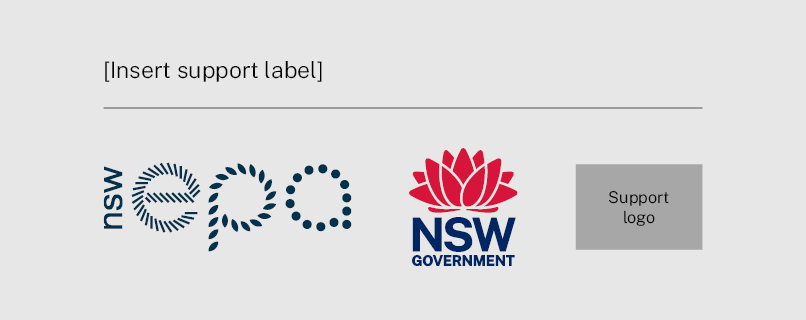
Note: Support labels and acknowledgement statements should follow the visual identity requirements of the communication lead.
Typography and minimum size
When the communication lead follows the NSW Government visual identity system (Masterbrand or Endorsed category), the support label should be set in the Public Sans typeface in the appropriate styling and weight according to the communication (in most scenarios this will be regular weight).
When the communication is from an external brand, the style of the support label should be in accordance with the external brand’s visual identity system requirements.
Support label sizing should be adjusted depending on the communication in order to retain legibility and readability for the customer.
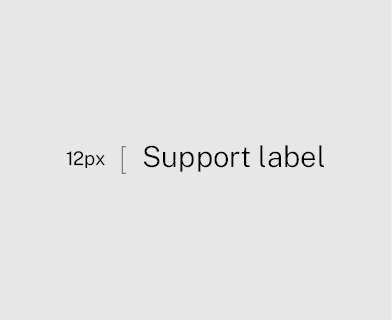
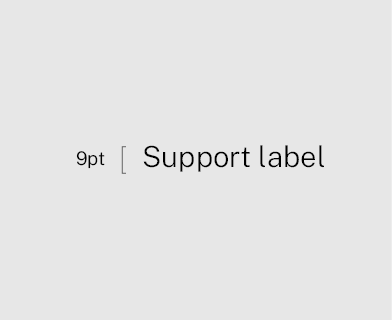
Acknowledgement statements
An acknowledgement statement is a long-form written acknowledgement that appears within the text of an application or alongside logos. Acknowledgement statements should be used to provide more clarity for complex relationships when space allows and when it will assist the customer’s understanding of the support relationship.
If you are a grantee or partnering with the EPA, you must acknowledge this support by using one of the below relevant statements:
- This project is an initiative of the NSW Environment Protection Authority under the NSW Government’s Waste and Sustainable Materials Strategy, and is funded from the waste levy.
- Brought to you by the NSW Government through the NSW Environment Protection Authority.
The phrasing of statements should be adjusted on a case-by-case basis to accurately convey the complex relationship in each scenario.
For applications with limited space such as digital banners and social media tiles, an acknowledgement statement can instead be inserted into the text of the social media post, or other accompanying communication channels such as websites.
Note: When an acknowledgement statement is included alongside logos, it needs to meet accessibility requirements.
Please contact communications@epa.nsw.gov.au if you have any questions.
Acknowledgement examples
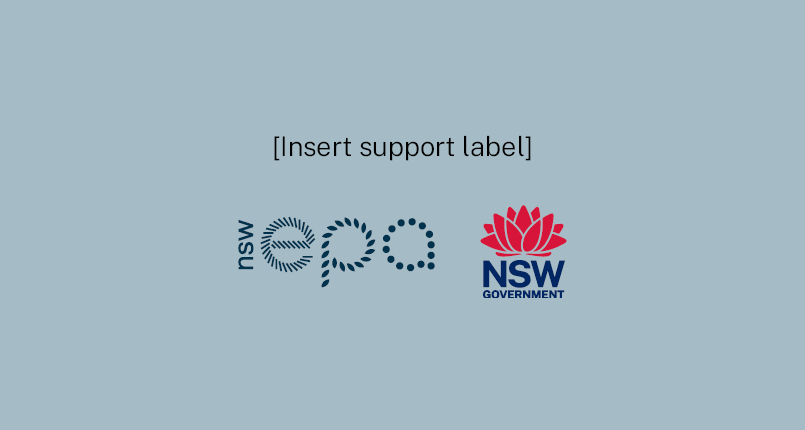
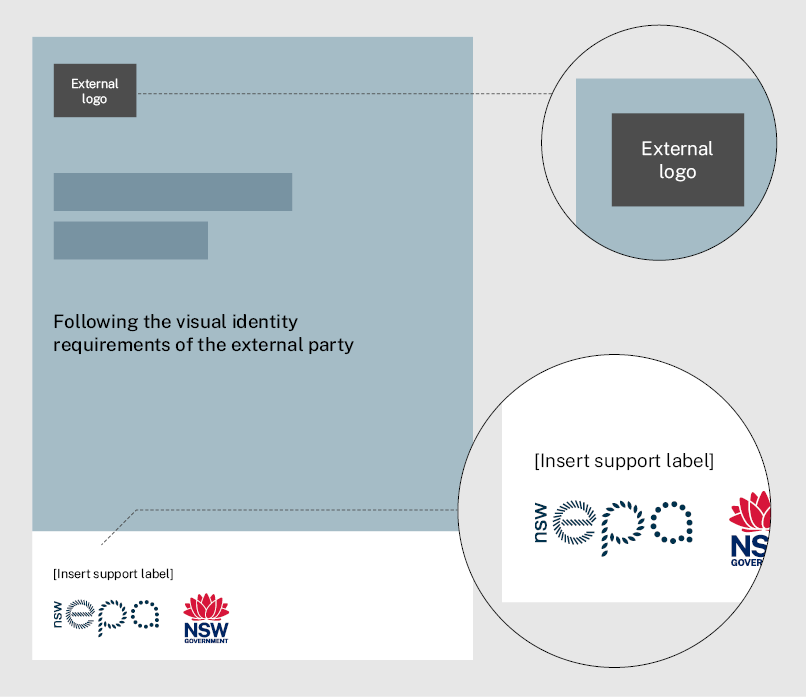

Sponsor walls
When space permits, multiple agency names can be included in a text acknowledgement statement next to the NSW Government logo to provide further context for a support relationship.
This example shows how in large spaces a descriptor acknowledgement statement can be used to communicate more detail around a support relationship.
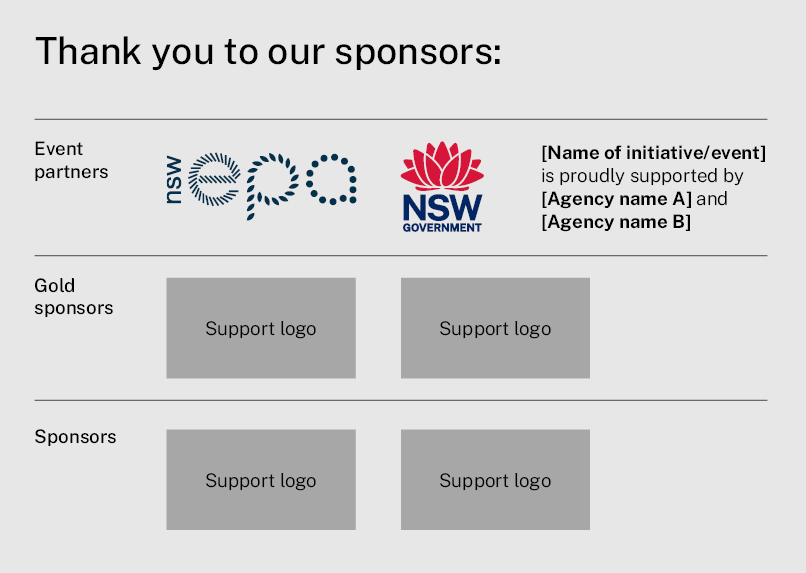
Digital ads (300x600)
Digital ads are quite limited in space, therefore (depending on the amount of content being shown) it may not be possible to show support logos without cluttering the communication and impacting the clarity for customers. Support information should instead be referenced in other applications throughout the customer journey if required, such as the website page.
The coupled logo without the word ‘Government’ in the NSW Government logo may be used in these instances.
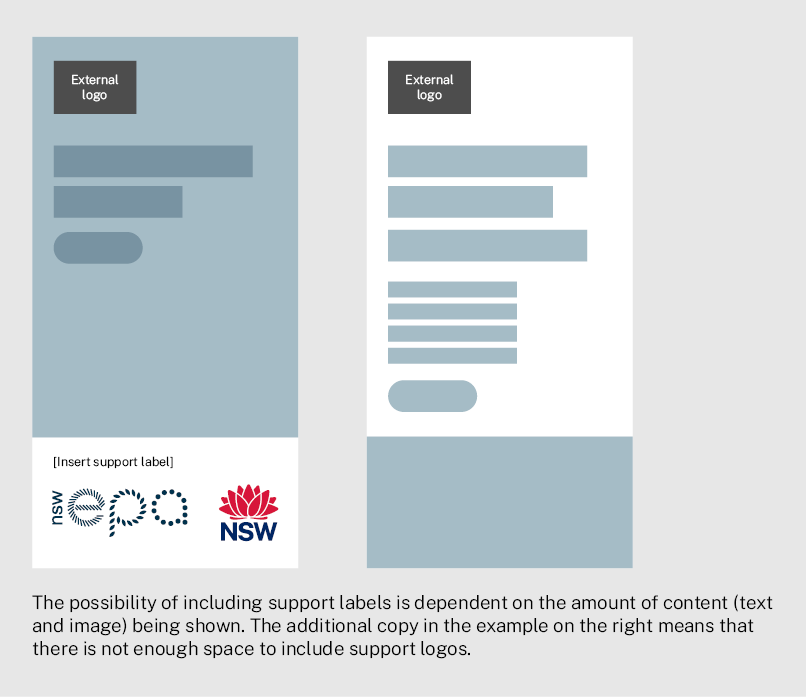
Social media posts

For social media posts with external party branding, the coupled logo without the word ‘Government’ in the NSW Government logo may be shown if appropriate. The height of the NSW Government logo should be a minimum of 115px. Alternatively, if there is not enough room to show the logos, support can be acknowledged through the text of the social media post, rather than cluttering the design with support logos.
If there are multiple images within the one post, the coupled logo may just be featured in the first image and does not need to feature on all images in the post.
Summary of design principles
- The brand that is leading the communication follows its own visual identity rules.
- Avoid displaying multiple NSW Government Waratah logos. This is to present clear and cohesive communications as being from the one NSW Government.
- Apply a support label in conjunction with logos to clarify and communicate the support relationship in text, to reduce the reliance on visuals to do so exclusively.
- Where multiple NSW Government parties provide support, these logos are to be ordered according to the hierarchy of the NSW Government Brand Framework. However, in the instance where the funding amount/contribution is to be recognised, the logos can be ordered instead based on the scale of their contribution.
- Where there are multiple supporting NSW Government agencies or programs/initiatives that are categorised under the Masterbrand category, the preference is for these to be represented exclusively through the use of the NSW Government Waratah logo without a descriptor (i.e. no agency name).
- Where support is recognised, logos must follow space recommendations to aid clarity and legibility.

